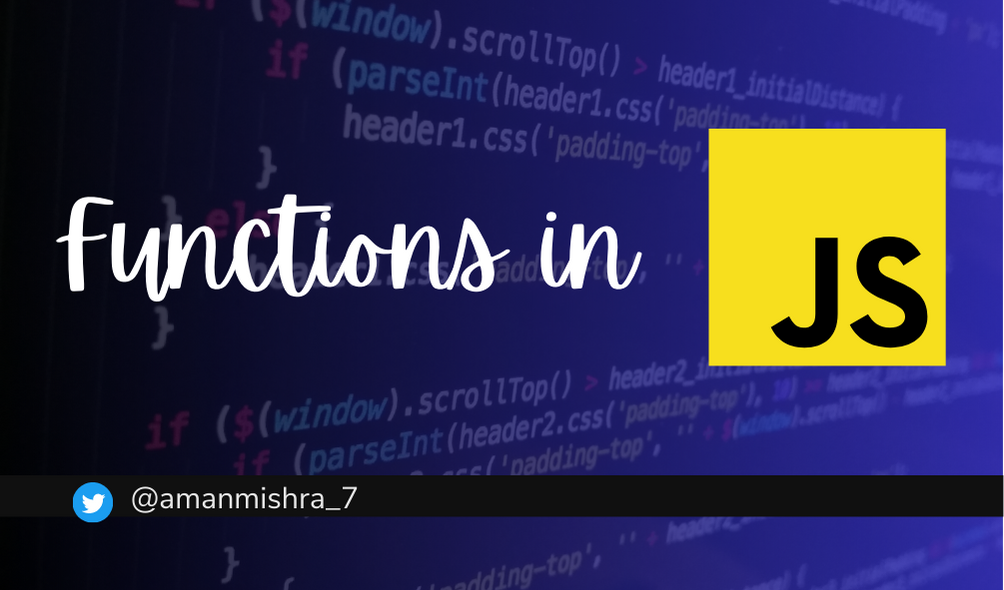Functions in JavaScript
 Aman Mishra
Aman Mishra
Title: Mastering Functions in JavaScript: A Comprehensive Guide with Examples and Code Snippets
Introduction: JavaScript is a versatile programming language that empowers developers to build dynamic and interactive web applications. One of its fundamental building blocks is functions, which enable the organization and reuse of code. In this blog, we will dive deep into understanding functions in JavaScript, exploring their syntax, types, and various concepts associated with them. With practical examples and code snippets, we will demonstrate how functions can enhance code modularity, readability, and maintainability.
Table of Contents:
The Basics of Functions
1.1 Function Definition
1.2 Function Invocation
1.3 Function Parameters and Arguments
1.4 Return Statements
Function Types and Scope
2.1 Named Functions
2.2 Anonymous Functions
2.3 Function Expressions
2.4 Immediately Invoked Function Expressions (IIFE)
2.5 Lexical Scope 2.6 Closures
Function Parameters and Arguments
3.1 Default Parameters
3.2 Rest Parameters
3.3 Argument Object
Higher-Order Functions
4.1 Callback Functions
4.2 Function Composition
4.3 Pure Functions
4.4 Recursion
Arrow Functions
5.1 Syntax and Usage
5.2 Lexical this Binding
5.3 Implicit Returns
Function Methods and Properties
6.1 Function.prototype.call()
6.2 Function.prototype.apply()
6.3 Function.prototype.bind()
6.4 Function.length Property
Function Best Practices
7.1 Avoiding Global Scope Pollution
7.2 Modularity and Encapsulation
7.3 Error Handling within Functions
7.4 Function Naming Conventions
Conclusion
Section 1: The Basics of Functions
1.1 Function Definition: In JavaScript, a function is defined using the function keyword followed by the function name, parameters (if any), and the function body enclosed in curly braces. Here's an example:
function greet(name) {
console.log("Hello, " + name + "!");
}
1.2 Function Invocation:
To execute a function, we need to invoke it by using the function name followed by parentheses. Here's an example:
codegreet("Aman"); // Output: Hello, John!
1.3 Function Parameters and Arguments: Parameters are placeholders defined in the function declaration, while arguments are the actual values passed to the function during invocation. Here's an example:
function add(a, b) {
return a + b;
}
const result = add(3, 5);
console.log(result); // Output: 8
1.4 Return Statements: Functions can return values using the return statement. The returned value can be stored in a variable or used directly. Here's an example:
function multiply(a, b) {
return a * b;
}
const result = multiply(2, 4);
console.log(result); // Output: 8
Section 2: Function Types and Scope In this section, we will explore various types of functions and how their scope affects their behavior.
2.1 Named Functions: Named functions are defined using a name identifier, making them reusable throughout the codebase. Here's an example:
function square(number) {
return number * number;
}
const result = square(5);
console.log(result); // Output: 25
2.2 Anonymous Functions: Anonymous functions, also known as function expressions, are defined without a name and can be assigned to variables. Here's an example:
const multiply = function(a, b) {
return a * b;
};
const result = multiply(3, 4);
console.log(result); // Output: 12
2.3 Function Expressions: Function expressions can also be immediately invoked or used as callbacks. Here's an example:
const result = (function(a, b) {
return a + b;
})(2, 3);
console.log(result); // Output: 5
2.4 Immediately Invoked Function Expressions (IIFE): IIFEs are self-invoking functions that execute immediately. They can be used to create private scopes and prevent global scope pollution. Here's an example:
(function() {
const message = "Hello, IIFE!";
console.log(message); // Output: Hello, IIFE!
})();
2.5 Lexical Scope: JavaScript functions create their own scope, and they can access variables from their own scope and outer scopes. Here's an example:
const name = "Aman";
function greet() {
console.log("Hello, " + name + "!");
}
greet(); // Output: Hello, John!
2.6 Closures: Closures allow functions to retain access to variables even after their outer function has finished executing. Here's an example:
function outer() {
var message = "Hello, ";
function inner(name) {
console.log(message + name);
}
return inner;
}
var innerFunction = outer();
innerFunction("John"); // Output: Hello, John!
Section 3: Function Parameters and Arguments
In this section, we will cover different aspects of function parameters and arguments, providing flexibility and functionality to functions.
3.1 Default Parameters:
Default parameters allow us to assign default values to parameters if no arguments are provided. Here's an example:
```javascript
function greet(name = "Guest") {
console.log("Hello, " + name + "!");
}
greet(); // Output: Hello, Guest!
greet("John"); // Output: Hello, John!
3.2 Rest Parameters: Rest parameters allow functions to accept an indefinite number of arguments as an array. Here's an example:
function sum(...numbers) {
return numbers.reduce((total, num) => total + num, 0);
}
var result = sum(1, 2, 3, 4);
console.log(result); // Output: 10
3.3 Argument Object: The arguments object provides access to all the arguments passed to a function, even if not defined in the function signature. Here's an example:
function greet() {
for (var i = 0; i < arguments.length; i++) {
console.log("Hello, " + arguments[i] + "!");
}
}
greet("John", "Jane", "Alice");
// Output:
// Hello, John!
// Hello, Jane!
// Hello, Alice!
Section 4: Higher-Order Functions Explore the concept of higher-order functions, which take other functions as arguments or return functions as results.
4.1 Callback Functions: Callback functions are functions passed as arguments to other functions and invoked later. Here's an example:
function calculate(operation, a, b) {
return operation(a, b);
}
function add(a, b) {
return a + b;
}
function subtract(a, b) {
return a - b;
}
var result1 = calculate(add, 5, 3);
console.log(result1); // Output: 8
var result2 = calculate(subtract, 8, 4);
console.log(result2); // Output: 4
4.2 Function Composition: Function composition allows combining multiple functions to create more complex behavior. Here's an example:
function square(x) {
return x * x;
}
function double(x) {
return x * 2;
}
var composedFunction = (x) => square(double(x));
var result = composedFunction(3);
console.log(result); // Output: 36
4.3 Pure Functions: Pure functions always produce the same output given the same input and have no side effects. Here's an example:
function multiply(a, b) {
return a * b;
}
console.log(multiply(3, 4)); // Output: 12
console.log(multiply(3, 4)); // Output: 12
4.4 Recursion: Recursive functions call themselves to solve a problem by breaking it down into smaller sub-problems. Here's an example of calculating factorial using recursion:
function factorial(n) {
if (n === 0) {
return 1;
} else {
return n * factorial(n - 1);
}
}
console.log(factorial(5)); // Output: 120
Section 5: Arrow Functions Explore the concise and expressive syntax of arrow functions and how they differ from regular functions.
5.1 Syntax and Usage: Arrow functions have a shorter syntax compared to regular functions and automatically bind the this value. Here's an example:
var greet = (name) => {
console.log("Hello, " + name + "!");
};
greet("John"); // Output: Hello, John!
5.2 Lexical this Binding: Arrow functions do not bind their own this value but instead inherit it from the surrounding scope. Here's an example:
var person = {
name: "John",
greet: function() {
setTimeout(() => {
console.log("Hello, " + this.name + "!");
}, 1000);
},
};
person.greet(); // Output: Hello, John!
5.3 Implicit Returns: Arrow functions with a single expression can have an implicit return without using the return keyword. Here's an example:
var double = (x) => x * 2;
console.log(double(5)); // Output: 10
Section 6: Function Methods and Properties Learn about useful built-in methods and properties available on functions.
6.1 Function.prototype.call(): The call() method allows borrowing functions and explicitly setting the this value. Here's an example:
function greet() {
console.log("Hello, " + this.name + "!");
}
var person = {
name: "John",
};
greet.call(person); // Output: Hello, John!
6.2 Function.prototype.apply(): The apply() method is similar to call(), but it accepts arguments as an array-like object. Here's an example:
function add(a, b) {
return a + b;
}
var numbers = [3, 5];
var result = add.apply(null, numbers);
console.log(result); // Output: 8
6.3 Function.prototype.bind(): The bind() method creates a new function with a preset this value and partially applied arguments. Here's an example:
function greet(greeting) {
console.log(greeting + ", " + this.name + "!");
}
var person = {
name: "John",
};
var greetPerson = greet.bind(person, "Hello");
greetPerson(); // Output: Hello, John!
6.4 Function.length Property: The length property returns the number of expected arguments for a function. Here's an example:
function multiply(a, b) {
return a * b;
}
console.log(multiply.length); // Output: 2
Section 7: Function Best Practices In this section, we will cover best practices to follow when working with functions to ensure code quality and maintainability.
7.1 Avoiding Global Scope Pollution: Minimize the use of global variables and functions to prevent naming collisions and maintain code clarity. Here's an example:
(function() {
var counter = 0;
function incrementCounter() {
counter++;
console.log(counter);
}
incrementCounter(); // Output: 1
})();
7.2 Modularity and Encapsulation: Use functions to create modular and reusable code by encapsulating related logic. Here's an example:
function calculateTax(income) {
// tax calculation logic
return taxAmount;
}
function calculateNetSalary(income) {
var tax = calculateTax(income);
var netSalary = income - tax;
return netSalary;
}
var salary = 5000;
var netSalary = calculateNetSalary(salary);
console.log(netSalary);
7.3 Error Handling within Functions: Handle errors within functions using try-catch blocks or by returning error values. Here's an example:
function divide(a, b) {
if (b === 0) {
throw new Error("Divide by zero error");
}
return a / b;
}
try {
var result = divide(10, 0);
console.log(result);
} catch (error) {
console.log(error.message); // Output: Divide by zero error
}
7.4 Function Naming Conventions: Follow naming conventions to ensure clarity and consistency in function names. Use descriptive names that convey their purpose. Here's an example:
function calculateSum(numbers) {
// calculation logic
return sum;
}
var numbers = [1, 2, 3, 4, 5];
var sum = calculateSum(numbers);
console.log(sum);
Conclusion: In this comprehensive guide, we have covered everything you need to know about functions in JavaScript. By mastering functions, you can unlock the full potential of JavaScript and write clean, modular, and maintainable code. Armed with practical examples and a deeper understanding of function concepts, you can enhance your JavaScript programming skills and build powerful web applications.
Remember, practice is key to becoming proficient in using functions effectively. So, go ahead, experiment with code, and continue exploring the fascinating world of JavaScript functions!
And As Always Functions are very beautiful in JavaScript and Fuction are the HEART🥰 of JavaScript
Subscribe to my newsletter
Read articles from Aman Mishra directly inside your inbox. Subscribe to the newsletter, and don't miss out.
Written by

Aman Mishra
Aman Mishra
🧠Data Structures and Algorithms | Python | Java | FullStack Development | Open Source